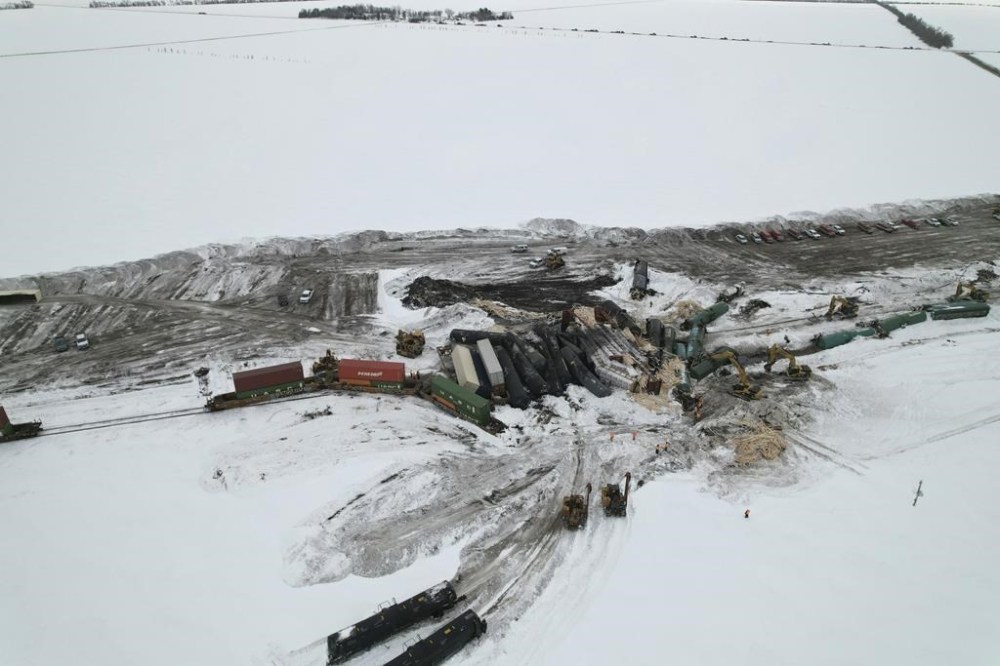Cold temps help contain chemicals in North Dakota derailment
Advertisement
Read this article for free:
or
Already have an account? Log in here »
To continue reading, please subscribe:
Monthly Digital Subscription
$0 for the first 4 weeks*
- Enjoy unlimited reading on winnipegfreepress.com
- Read the E-Edition, our digital replica newspaper
- Access News Break, our award-winning app
- Play interactive puzzles
*No charge for 4 weeks then price increases to the regular rate of $19.00 plus GST every four weeks. Offer available to new and qualified returning subscribers only. Cancel any time.
Monthly Digital Subscription
$4.75/week*
- Enjoy unlimited reading on winnipegfreepress.com
- Read the E-Edition, our digital replica newspaper
- Access News Break, our award-winning app
- Play interactive puzzles
*Billed as $19 plus GST every four weeks. Cancel any time.
To continue reading, please subscribe:
Add Free Press access to your Brandon Sun subscription for only an additional
$1 for the first 4 weeks*
*Your next subscription payment will increase by $1.00 and you will be charged $16.99 plus GST for four weeks. After four weeks, your payment will increase to $23.99 plus GST every four weeks.
Read unlimited articles for free today:
or
Already have an account? Log in here »
Hey there, time traveller!
This article was published 28/03/2023 (989 days ago), so information in it may no longer be current.
The cold weather in North Dakota kept chemicals that spilled from a derailed Canadian Pacific train from spreading very far, authorities said.
Richland County Emergency Management Director Brett Lambrecht said Tuesday that with temperatures well below freezing all of the chemicals that leaked remained within about 100 feet of the derailment that happened Sunday night in a rural area about 60 miles (97 kilometers) southwest of Fargo. The high temperature in the area was forecast to reach only 17 degrees Fahrenheit (-8 degrees Celsius) Tuesday.
“The weather conditions helped a lot,” Lambrecht said.

No injuries or fire were reported in the derailment and no one had to be evacuated in the two nearby farm houses or in the town of Wyndmere a couple miles away. There are no waterways near the derailment.
Lambrecht said that the liquid asphalt and ethylene glycol that spilled from six railcars involved in the derailment mostly hardened and remained on the surface of the ground because of the cold weather. Some propylene gas also leaked from a tank car that was punctured in the crash, but officials were able to patch the leak on that car. He said the liquid asphalt looked like “sheets of black plastic” after it froze.
Officials aren’t yet sure how much of the chemicals spilled, but none of the railcars that leaked spilled all their contents.
A total of 31 of the 70 cars on the train derailed. Canadian Pacific officials have said they believe a broken rail caused the derailment.
The railroad was able to clear the tracks and resume running trains through the area Monday evening, but Canadian Pacific is still working on clearing all the damaged cars from the site.
“It has been a good fast recovery really when you look at it,” Lambrecht said.
The cleanup of the chemicals is expected to take about two weeks. The railroad’s own hazardous materials experts are working with local officials.
Last month’s fiery derailment outside East Palestine, Ohio, near the Pennsylvania border renewed interest in railroad safety. Federal regulators and members of Congress proposed a number of safety reforms after that Norfolk Southern derailment. The major freight railroads also said they would install about 1,000 more trackside detectors in the wake of that derailment to help spot equipment problems before they could cause future derailments.



